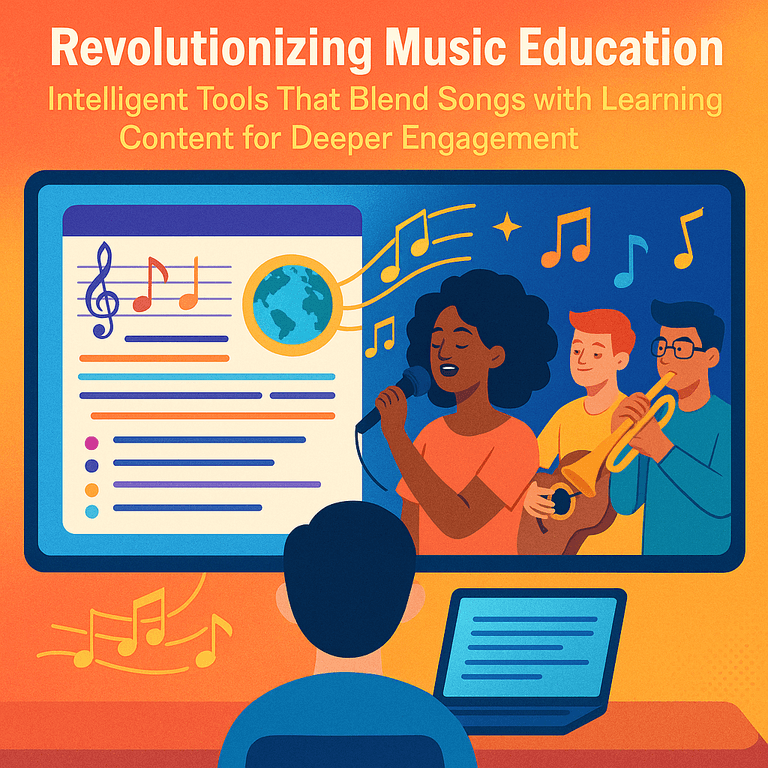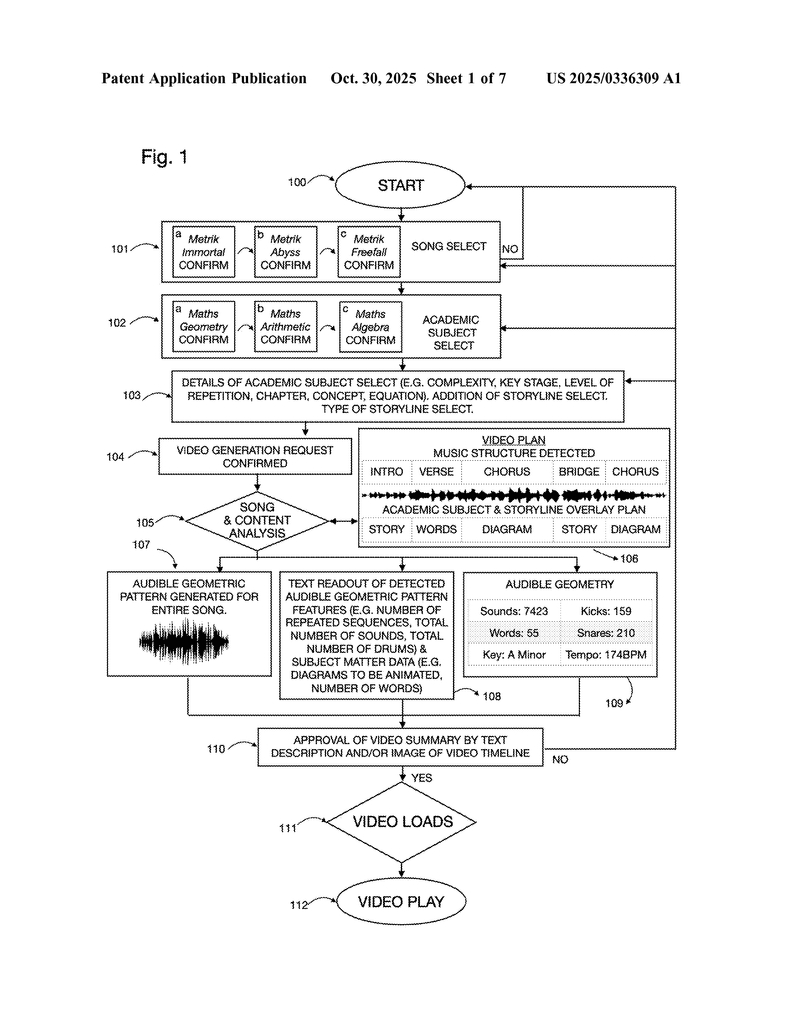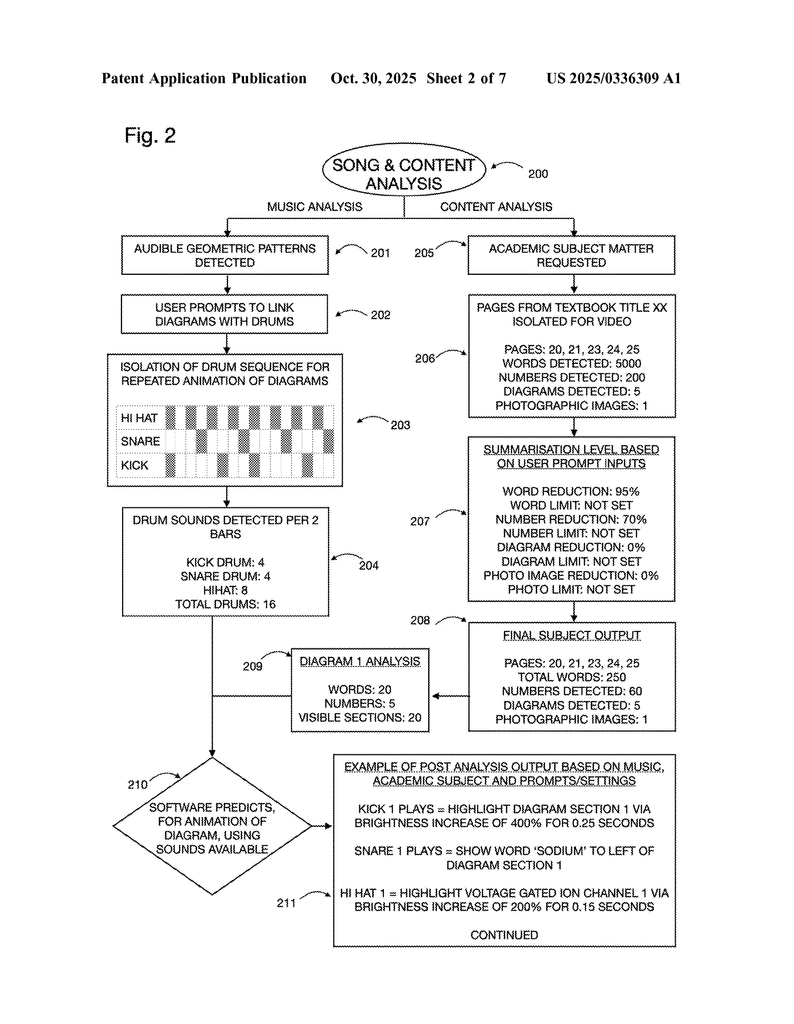Invented by Weaver; Felix Benjamin
Learning can be hard, especially when the material feels boring or tough to remember. But what if we could mix the fun parts of music and animation with schoolwork? A new patent application describes a way to do just that, combining music, text, images, and even stories into powerful learning videos. In this article, we’ll break down this invention, look at why it matters, and see how it could change the way we learn forever.
Background and Market Context
From the start, humans have always found new ways to share and remember what’s important. We drew on cave walls, made up songs, and passed stories from person to person. As time went on, we invented writing, books, and later, computers and the internet. Now, almost everyone can read, watch, or listen to information on a phone or tablet. But even with all these new tools, our brains still work in the same old ways—they remember things better when learning is fun, meaningful, and tied to emotions.
Most schools still use books, lectures, and worksheets. For some kids and adults, this works fine. But for many, it’s hard to pay attention or remember facts. That’s why teachers have long used memory tricks, called mnemonics, to help. One classic method is the alphabet song. Kids don’t just read the letters—they sing them, which makes the learning stick. Adults, too, use tricks like “Every Good Boy Deserves Fruit” to remember music notes, or turn numbers into stories to memorize long lists.
In today’s world, technology lets us watch videos that teach math, science, history, or even how to fix a bike. There are thousands of songs and playlists called “music to study to,” and lots of fun apps with flashcards and quizzes. But these usually keep music and learning separate. The music is just background noise, not part of the lesson itself.
Some people, like memory champions, use even more advanced tricks. They create “memory palaces” in their minds, linking facts to rooms or objects. Others, especially people who think differently—like those with autism, ADHD, or dyslexia—learn better with pictures, stories, or hands-on activities. Studies show that music and emotion both help the brain remember things longer. But until now, there hasn’t been an easy way to blend all these methods into one tool.
The market for digital learning is huge and growing fast. Schools, parents, and learners are hungry for new ways to make lessons stick. Companies are racing to build better apps, smarter AI tutors, and more engaging content. Yet, most solutions focus on giving more access to information, not making the learning process itself smarter or more memorable. This is where the new invention comes in, offering a fresh way to combine music, visuals, and stories, tailored for each learner.
Scientific Rationale and Prior Art
Why does mixing music, visuals, and stories work so well for learning? It all goes back to how our brains are wired. When we hear a catchy tune, see a vivid picture, or feel strong emotions during a story, the brain pays attention. These moments trigger chemicals that help us remember. Scientists call this “multi-sensory learning”—using more than one sense at a time to make memories stronger.
Melodic learning, like singing the alphabet, isn’t new. It helps because music is naturally patterned and repeats, making it easier for the brain to remember sequences. The rhythm and melody act as a scaffold, holding the facts together. Kids aren’t just memorizing the letters—they’re remembering the song, which contains the letters. That’s why they can later recall the alphabet with ease.
Adults sometimes use spatial memory, linking facts to imaginary places—the “memory palace” trick. This method is especially powerful for remembering long lists or complex info, because it uses the brain’s built-in skill for remembering locations and images. It’s a favorite of memory champions, but not often used in regular classrooms.
People who struggle with reading, writing, or attention often do better when lessons include visuals, stories, or movement. For example, kids with dyslexia may find it easier to remember words shown as pictures, or when learning is turned into a game. Music can also help people with autism or ADHD focus and organize their thinking. Emotions, too, play a key role—when a lesson is exciting, funny, or dramatic, it sticks better.
In the world of educational technology, there are tools that use music or visuals alone, and some that use stories or games. But most treat these elements separately. For example, you might watch a math video with background music, or play a spelling game with sound effects. There are apps that let you pick a subject and a song, but they don’t truly blend the two—they run side by side, not together.
Artificial intelligence (AI) has started to change this, but even the smartest AI tutors today mostly offer personalized quizzes, hints, or explanations. They don’t analyze the structure of a song, split it into notes, and then match each note to a learning point. Instead, they use simple timers or random order. There are some music visualization tools, and some programs that let you animate diagrams, but there hasn’t been a tool that fully integrates music, images, stories, and learning material into one synchronized experience.
Some video games and animated shows use music to heighten drama, or to signal important moments. But in education, using music as a timing guide for when to show each fact or picture—pairing a drumbeat with a diagram, or a lyric with a key idea—is a new approach. It’s a step beyond just making learning “fun” or “engaging.” It aims to use the brain’s natural pattern-finding and memory systems to boost how well we learn and remember.
With the rise of AI, smartphones, and cheap digital storage, it’s finally possible to analyze music in detail, split it into tiny pieces, and use those as building blocks for lessons. This patent application describes a system that does just that. It uses AI to break down both the music and the learning material, then pairs them up in a way that’s designed not just to entertain, but to help the brain remember more, faster.
Invention Description and Key Innovations
This invention is a method and system for making educational videos that are tightly woven with music. Here’s how it works, in simple steps:
First, the system gets two things from the user: a piece of music (like a song) and some educational content (like text, diagrams, or a subject from a textbook). It can be any type of music—pop, jazz, classical, or even a custom tune. The educational content can cover anything from math to science, history, or language.
Next, the AI analyzes both the music and the learning material. For the music, it doesn’t just play the song—it breaks it down into smaller pieces. It finds every note, every beat, every word in the lyrics, and even the pattern of drums or changes in melody. The AI can tell how long each section lasts, how loud it is, and what instruments are playing.
For the educational content, the AI scans the text, picks out key words, important sentences, and diagrams. It figures out how the information is organized, what pictures go with which ideas, and how complex each part is. If the content comes from a textbook, the AI can even break it down by chapter, section, or topic.
Then comes the magic: the AI matches up pieces of music with pieces of learning material. For example, it might pair each drumbeat with a new diagram, or each lyric with a key idea or step in a process. The timing is precise—so as the music plays, the visuals change in perfect sync. If the user wants, they can set their own preferences: maybe focus more on diagrams, or repeat key facts, or add a story with characters who act out the lesson.
The result is a video where the song and the lesson are woven together. A math equation might be built piece by piece with each note. A science diagram might light up or move in time with the chorus. An anime-style character might act out a story that fits the lesson, moving to the rhythm of the music. The user can choose the subject, the level of difficulty, and even the style of animation or story.
What’s really clever is how the system lets users shape their own learning experience. You can pick which song to use, which subject to learn, and how deep you want to go. If you’re getting ready for a test, you can focus on just one diagram or concept and have it repeat in time with the music. If you want more fun, you can add a dramatic story or watch the lesson unfold as an exciting cartoon. The AI can even suggest ways to chunk information or use memory tricks (like acronyms or visual patterns) based on what works best for you.
All the heavy lifting is done by an artificial neural network—a kind of AI brain that learns by looking at lots of examples and figuring out patterns. This network has special parts for taking in music, text, images, and user settings. It processes everything, matches up the right pieces, and spits out a ready-to-play video plan. The user can review, edit, or approve the plan before watching the final video.
The system can also show you how the music breaks down visually—as a geometric pattern or “music stem”—making it easy to see the structure of the song. You can see which parts are loud or quiet, where the chorus is, and how the lesson fits into the flow of the music. If you want, you can dig into the details: see how many sounds were found in the song, how many words or diagrams are in the lesson, or even customize which instrument triggers which visual.
On top of all that, the system can add progress tracking, quizzes, and a personal profile. You can see how much you’ve learned, what subjects you’ve covered, and compare your progress to other users. The whole system is designed to be easy to use for learners of all ages, from kids to adults, and can work on phones, tablets, computers, or even virtual reality headsets.
This invention stands out because it doesn’t just put music and learning side by side—it fuses them together, making each beat or lyric a cue for new knowledge. The AI can handle all sorts of subjects and styles, and can adapt to each learner’s needs. By bringing together the best of music, visuals, stories, and memory science, it opens up a new world for learning—one that’s fast, fun, and unforgettable.
Conclusion
The patent application we explored here points to a future where learning is as natural and enjoyable as singing your favorite song or watching a favorite show. By harnessing the brain’s love of patterns, music, and stories, this invention could help people learn faster, remember more, and maybe even enjoy subjects they once found boring or hard. With AI doing the heavy lifting—analyzing music, splitting up lessons, and matching everything in perfect time—the barriers to learning fall away. If you’re a parent, teacher, or student, this could mean more than just better grades. It could mean a lifelong love of learning, built note by note, story by story, and memory by memory. The world of education is changing fast, and with inventions like this, the best is yet to come.
Click here https://ppubs.uspto.gov/pubwebapp/ and search 20250336309.




